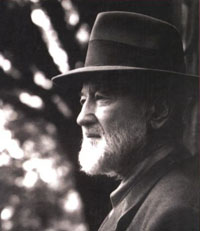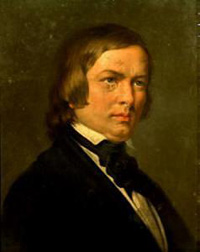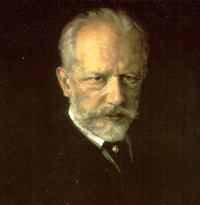| TCHAIKOVSKY – FOURTH SYMPHONY | ||||||||||
The Unanswered Question Charles Ives was one of the few artists with the luxury of exercising his full creative energies unimpeded by a need to eke out a living from his art. He was the son a Connecticut bandleader who had started his career as the youngest bandleader in the Union Army but who wanted his son to be a concert pianist. From his father, Charles developed an appreciation for musical games, such as singing in one key and playing in another, or playing the same piece in two keys simultaneously. Perhaps it was this penchant for duality that led him to embark on a double life. He had an enormously successful career in insurance, applying his creativity and idealism to develop important new concepts for the life insurance industry, while at the same time experimenting and composing in his idiosyncratic musical style. Ives composed The Unanswered Question in 1906. It was the first of Two Contemplations (the other being Central Park in the Dark) that employ the techniques of polytonality and polyrhythm. Ives claimed to have become fascinated with simultaneous contrasting rhythms and tonalities from having heard two or more bands playing different tunes within earshot of each other at parades. The work consists of three separate, musically unrelated performers: a string orchestra playing a series of long, whispering chords in traditional harmony;  a solo trumpet repeating six times the same five-note atonal motive in a totally foreign “key;” a solo trumpet repeating six times the same five-note atonal motive in a totally foreign “key;”  and a quartet of flutes (sometimes four woodwinds), providing increasingly frenzied responses to the trumpet with yet another atonal series of notes. and a quartet of flutes (sometimes four woodwinds), providing increasingly frenzied responses to the trumpet with yet another atonal series of notes.  In a later revision of the work, Ives provided a brief program for the piece, which may or may not have been in his mind at the time of its original composition. In a later revision of the work, Ives provided a brief program for the piece, which may or may not have been in his mind at the time of its original composition.“The strings are the silences of the Druids, who know, see, and hear nothing.” Over this background the trumpet “poses the perennial question of existence; and the winds are “the fighting answerers,” who flounder around, even frantically restating the question as if to clarify it, but in their distortion of the motive, showing that they never understood it in the first place.” As if he were trying to further demonstrate the lack of communication between the three ensembles – and hence the lack of resolution to the question – Ives even leaves the coordination of the final moments of the piece to each individual group of performers and their conductor (if they have one). | ||||||||||
Piano Concerto in A minor, op. 54 No other composer symbolized the romantic movement in music as did Robert Schumann. Talented both in music and literature, he used the latter to promote his romantic ideals about the future of music. He was a true elitist, pitting “us,” the enlightened (the Davidsbündler), against “them,” the masses (whom he called “Philistines”). The latter appellation has remained part of the international elitist vocabulary to this day. Schumann’s five-year pursuit of his beloved, the brilliant Clara Wieck, had all the ingredients of a soap opera (or grand opera): A hostile father-in-law, an adoring young bride-to-be, secret correspondence, lawsuits and court battles, accusations of alcoholism, banishment from Wieck's house, economic pressure, etc. Clara was an outstanding pianist and composer in her own right, and their eventual triumph led to a stormy but happy marriage unleashing a flood of creativity in both husband and wife – including eight children. The popular piano concertos of Schumann’s time were mostly empty showpieces, written by virtuosos for virtuosos. Schumann detested what he considered to be the second-rate composers of such works, calling them "Gladiators of the Keyboard." When in 1841 he wrote his first symphonic works, including his Symphony No. 1 and sketches for what was to become No. 4, he also wrote a Fantasie for piano and orchestra that turned out to be the embryonic first movement of the Piano Concerto. He wrote the Fantasie for Clara, who performed it privately with the Leipziger Gewandhaus Orchestra under Felix Mendelssohn just before going into labor. She wrote in her diary during rehearsals: “The piano part is woven most finely into the orchestral texture: one cannot imagine one existing without the other.” Publishers, however, were not so enthusiastic about the piece, and no public performance took place. Three years later, in the summer of 1844, after just returning from an arduous concert tour of Russia, Schumann suffered a nervous breakdown that left him barely able to work. During the following year, he composed little but managed to expand the Fantasie into a full-fledged three-movement piano concerto, and it was Clara, now a prestigious soloist, who practically forced it on the musical establishment. Often criticized as a mediocre orchestrator, Schumann brings some of his best orchestral writing to this concerto, particularly in the wonderful oboe and clarinet solos in the first movement. The thematic exposition is a piece of teamwork for orchestra and soloist: the first theme is introduced by the oboe, echoed by the piano,  while the second theme is introduced by the piano and orchestra together and grows organically out of a small motive. while the second theme is introduced by the piano and orchestra together and grows organically out of a small motive.  Although there are, of course, many solo sections for piano, much of the movement integrates the soloist into the instrumental fabric, often accompanying another instrument which carries the theme. Although there are, of course, many solo sections for piano, much of the movement integrates the soloist into the instrumental fabric, often accompanying another instrument which carries the theme.  The development section is more of a fantasy, typical of the composer's rapid mood swings, perhaps even a deliberate self-portrait of the two sides of his personality, the exuberant Florestan and the contemplative Eusebius whom he described about in his critical writings. But strangely, the recapitulation is more literal than almost any in the nineteenth century repertory. After the lengthy cadenza the coda suddenly picks up the tempo with another development of the first few notes of the principal theme. The development section is more of a fantasy, typical of the composer's rapid mood swings, perhaps even a deliberate self-portrait of the two sides of his personality, the exuberant Florestan and the contemplative Eusebius whom he described about in his critical writings. But strangely, the recapitulation is more literal than almost any in the nineteenth century repertory. After the lengthy cadenza the coda suddenly picks up the tempo with another development of the first few notes of the principal theme.  The "Intermezzo," is a gentle respite from the majestic opening movement, but with elegant leaps in the opening theme  and a sighing motive. and a sighing motive.  The langorous sigh is picked up in the second theme as well, The langorous sigh is picked up in the second theme as well,  yet creating more of a pensive than a melancholy air. Using the opening motive from the Concerto as a transition, the Intermezzo leads without pause into the rollicking Finale. yet creating more of a pensive than a melancholy air. Using the opening motive from the Concerto as a transition, the Intermezzo leads without pause into the rollicking Finale.  Like any rondo, it provides an opportunity to spin out a substantial number of themes in the episodes between the rondo's reappearance. The second theme sounds like a march but is notated in 3/4. Like any rondo, it provides an opportunity to spin out a substantial number of themes in the episodes between the rondo's reappearance. The second theme sounds like a march but is notated in 3/4.  From the crashing opening chords to the unbroken transition between the second and final movements and even the theme itself of the final rondo, Schumann reveals his debt to Beethoven, especially the latter's "Emperor" Concerto. Yet his blending of piano and orchestra is strikingly original. Another departure from classical and virtuoso concerti is the absence of a cadenza in the last movement (despite the fact that the Concerto was written for his virtuoso wife). | ||||||||||
Symphony No. 4 in F minor, Op. 36 In the roster of Russian nationalist composers at the end of the nineteenth century, Pyotr Ilyich Tchaikovsky was an oddity. Although an ardent nationalist, he did not espouse the Nationalist movement in music, symbolized by such composers as Modest Mussorgsky, Aleksander Borodin, Mily Balakirev and Nikolay Rimsky-Korsakov. Despite the many folk elements in his music, his great melodic gift enabled him to develop his own themes and only occasionally use borrowed melodies. Instead of nationalistic themes, his music usually was a vehicle to express his personal anguish and erratic mood swings. The son of a mining engineer, Tchaikovsky had an economically comfortable but unsettled childhood, as his father relocated from one post to the other. He was a precocious child with a gift for words, reading French and German at age six; the seven-year-old started to write a biography of Joan of Arc. The family recognized Tchaikovsky’s musical talents, but in 1852 he was entered into St. Petersburg’s School of Jurisprudence, which he attended for seven years. It was there that he first became aware of his homosexuality; he took its negative social implications seriously, especially the effect it could have on his family. His emotional conflict exacerbated extreme mood swings with frequent bouts of deep depression and self-doubt that dogged him from childhood until his death. The School of Jurisprudence provided a well-rounded education, including music, and Tchaikovsky also availed himself also to the many cultural opportunities of the city. After graduation he was assigned a job in the Ministry of Justice, but music became more and more the center of his cultural life. His serious musical studies began in 1861; a year later, he was accepted into the first class of the newly opened St. Petersburg Conservatory, graduating in 1865. His principal teacher was pianist and composer Anton Rubinstein, whose strong personality instilled in Tchaikovsky compositional discipline: to sketch quickly to the end of a work, then score; work every day, and hold to music as a sacred calling. After graduation, Tchaikovsky was recruited by Nikolay Rubinstein, Anton’s brother, for the new music conservatory in Moscow. But he was not a good teacher, ever dogged by feelings of insecurity. He also resented the time it took away from composing. Things were actually looking up for Tchaikovsky during the early part of 1877. He had his first contact with Nadezhda von Meck, the wealthy widow of a railroad builder, who fell in love with Tchaikovsky’s music and arranged to pay him a large annual stipend. The only stipulation she attached to her generous help was that they never meet in person, although they corresponded voluminously. In May he started work on the Fourth Symphony, but in July came his disastrous marriage to one of his students, Antonina Milyukova, who had fallen madly in love with him and had written to him confessing her devotion. Although Tchaikovsky, who was homosexual, didn’t even remember the girl, he hoped the marriage would still the rumors about his sexual preference. Instead he fled Antonina after two weeks. In total despair, he made a pathetic attempt at suicide (he walked into the Moskva River, hoping to die of pneumonia) and ended up with a complete mental collapse. To recuperate, his brother took him to Switzerland and Italy, where he picked up work on the symphony, finishing it in January 1878. Tchaikovsky dedicated the work To Mme. von Meck, expressing his confidence in the new work: “I feel in my heart that this work is the best I have ever written.” He himself did not return from abroad for the February 1878 premiere in Moscow, which was only a luke-warm success.Tchaikovsky himself contributed to the notion that the Symphony was programmatic. He wrote to his patroness: Of course my symphony is programmatic, but this program is such that it cannot be formulated in words. That would excite ridicule and appear comic. Ought not a symphony – that is, the most lyrical of all forms – to be such a work? Should it not express everything for which there are no words, but which the soul wishes to express, and which requires to be expressed?In Tchaikovsky's last three symphonies, motivic unity among the movements was to take an increasingly more prominent role. The symphony opens with a sinister fanfare-like theme by the brass, which recurs as the movement unfolds.  The anxiety-laden main theme, which Tchaikovsky develops on the spot, strives towards a resolution that continually seems to elude it. The anxiety-laden main theme, which Tchaikovsky develops on the spot, strives towards a resolution that continually seems to elude it.  The relief comes with the second theme, one of Tchaikovsky's inimitable melodies, a waltz for solo clarinet, The relief comes with the second theme, one of Tchaikovsky's inimitable melodies, a waltz for solo clarinet,  and a third played in counterpoint with the clarinet theme by the strings and timpani. and a third played in counterpoint with the clarinet theme by the strings and timpani.  The development, based exclusively on the main theme and the fanfare, begins quietly, slowly ramping up the emotional tension. After the recapitulation, the fanfare announces a long two-part coda with a new theme set contrapuntally against the main theme to resolve the movement on a more positive note. The development, based exclusively on the main theme and the fanfare, begins quietly, slowly ramping up the emotional tension. After the recapitulation, the fanfare announces a long two-part coda with a new theme set contrapuntally against the main theme to resolve the movement on a more positive note.  But just as we are starting to sit back and relax, the fanfare returns to blast us back into Tchaikovsky's stormy reality. But just as we are starting to sit back and relax, the fanfare returns to blast us back into Tchaikovsky's stormy reality.  The second movement, by contrast, opens with a plaintive melody on the oboe, accompanied by pizzicato strings.  The oboe theme is answered by a more intense second theme in the strings. The oboe theme is answered by a more intense second theme in the strings.  The pace picks up as the composer adds a dance-like melody. The pace picks up as the composer adds a dance-like melody.  Typical Tchaikovsky anxiety mounts, Typical Tchaikovsky anxiety mounts,  until he returns to the gentle oboe theme now in the violins, adorned with feathery ornaments in the winds recalling the accompaniment to the clarinet theme in the first movement. until he returns to the gentle oboe theme now in the violins, adorned with feathery ornaments in the winds recalling the accompaniment to the clarinet theme in the first movement.  The third movement, Pizzicato ostinato, is a playful diversion.  It is a typical scherzo and trio. The Trio consists of a medley of tunes, the first for a pair of oboes, It is a typical scherzo and trio. The Trio consists of a medley of tunes, the first for a pair of oboes,  the second, slightly mournful Russian folk tune, also for the upper winds, the second, slightly mournful Russian folk tune, also for the upper winds,  and a playful brass riff with staccato playing to match the pizzicato strings from the Scherzo. and a playful brass riff with staccato playing to match the pizzicato strings from the Scherzo.  The movement ends with a medley of the various themes and instrumental combinations. The movement ends with a medley of the various themes and instrumental combinations.  While one hears subtle references to first-movement musical ideas in movements two and three, Tchaikovsky explicitly unifies the Symphony in the Finale. This last movement is the most “Russian” of Tchaikovsky’s symphonic movements and is something of a musical battle between the festive and the melancholic. After a festive opening theme,  the oboe and bassoon introduce an authentic Russia folk-song (for which he was roundly condemned by his academic colleagues and the critics). the oboe and bassoon introduce an authentic Russia folk-song (for which he was roundly condemned by his academic colleagues and the critics).  Once again, however, a sprightly mood turns negative, Once again, however, a sprightly mood turns negative,  and it is hardly surprising that the movement is brought up short towards the end by the reappearance of the grim fanfare from the opening movement – the spectre at the feast. and it is hardly surprising that the movement is brought up short towards the end by the reappearance of the grim fanfare from the opening movement – the spectre at the feast.  An energetic coda, however, tips the balance towards positive territory. An energetic coda, however, tips the balance towards positive territory. | ||||||||||
| Copyright © Elizabeth and Joseph Kahn 2016 | ||||||||||


